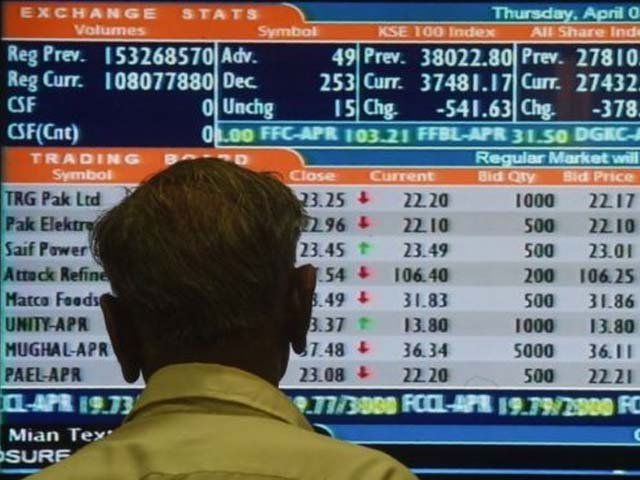
A Pakistani stockbroker watches the latest share prices during a trading session. PHOTO: AFP
Why should Pakistan change its export policy?
Pakistan needs to exploit its $12.8 billion potential for exports while investing in research and development
In the current inhospitable economic climate prevailing in Pakistan, leading to rising inflation alongside a worsening trade and fiscal deficit, the nation desperately needs a solution to these growing list of problems. While it is fairly simple to understand that an increase in exports will benefit the economy, the method through which this can be achieved is a slightly more tricky question to answer. Exports will help pave the way towards economic prosperity by improving Pakistan’s Balance of Payment (BoP), but policies which try to lead Pakistan in this direction can only be implemented once we address the question: why does Pakistan have such few exports?
The dilemma facing Pakistan is that the primary commodities which it exports – like cotton, sugar, leather and textiles – do not have a stable price in the international market, as a result of which expected export earnings can not be guaranteed. Pakistan has restricted its export to a few primary and intermediate goods instead of value added or finished products, which has naturally led to a poor BoP. The simple truth of the matter is that the primary and secondary products Pakistan provides for the world are currently unable to correct a current account deficit.
However, it is important to concede that the key reason behind the continuously declining export is the clash between trade policies and monetary policies. This is further complicated by the fact that consumers have very little confidence in the Pakistani economy. Consequently, the low inflow of Foreign Direct Investment (FDI) has meant that Pakistan’s exports are also suffering as a consequence. Ultimately, there are a whole host of internal and external factors that have damaged Pakistan’s export sector and caused it to lag behind the world.
The export sector has suffered due to a reliance on foreign resources, low production of commodities that have high domestic demand, poor governance, incompetence and corruption. This in turn has meant that Pakistan’s enterprises are nowhere to be found in the global value and supply chains, which has resulted in inadequate facilitation procedures of trade, inadequate support from the government bodies, and an unavailability of financing for small and medium enterprises (SMEs). Other constraints include an unreliable energy supply, poor infrastructure, old-fashioned technology and weak contract enforcement. As a result, Pakistan only has a few export commodities and has only limited markets which can be used as destinations for Pakistan’s exports. But the Strategic Trade Policy Framework (STPF), initiated by the Ministry of Commerce will have a crucial role to play in improving exports.
The framework was launched with the aim to enable Pakistani firms to export diversified and innovative products in order to be a part of a highly competitive global trading environment. The STPF includes a focus on macro policies which intend to enhance the value of Pakistan’s exports, increase product competitiveness, product diversification, market diversification and develop a sustainable manufacturing model in Pakistan. An implementation of these changes is the need of the hour.
The problem behind Pakistan’s current export conundrum is that although many five year plans and medium term frameworks have been designed, their implementation is circumspect. The trade deficit can only be rectified if we improve the quality of our products, market them effectively, and invest in research and development in order to ensure that our exports are competitive in the international market. There is also a desperate need to fix the textile sector by upgrading its units and ensuring that a uniform policy is put into place to govern the sector. Furthermore, Pakistan’s currency depreciation has meant that competitors like India and Bangladesh have managed to race ahead in the international market.
In Pakistan, product concentration is much higher as compared to other countries, therefore, there is a need to formulate a strategy that would increase the product base and reduce dependence on other primary products like cotton and rice. But increasing exports and improving their standard alone is not enough. A stock of exports is useless is there is no place to ship them to. Pakistan needs to ensure that it taps into other international markets and moves beyond only sending its products to its handful of trading partners like America, England, China and the United Arab Emirates (UAE). Pakistan has to ensure that its currently untapped $12.8 billion potential for exports is exploited to its fullest because a thriving export sector is imperative if the government wants to pull Pakistan out of the current economic slump.

COMMENTS
Comments are moderated and generally will be posted if they are on-topic and not abusive.
For more information, please see our Comments FAQ